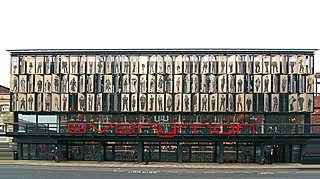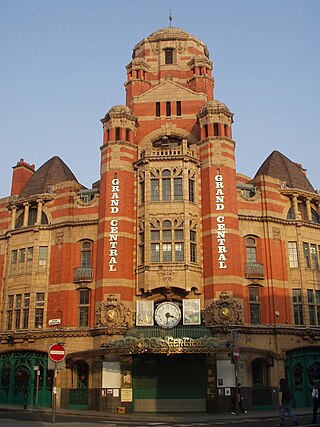
Croxteth Hall is a country estate and Grade II* listed building in the West Derby suburb of Liverpool, England. It is the former country estate and ancestral home of the Molyneux family, the Earls of Sefton. After the death of the seventh and last Earl in 1972, the estate passed to Liverpool City Council, which now manages the remainder of the estate following the sale of approximately half of the grounds. The remaining grounds, Croxteth Park, were at one time a hunting chase of the Molyneux family and are now open to the public.

Toxteth is an inner-city area of Liverpool in the county of Merseyside.
BBC Radio Merseyside is the BBC's local radio station serving Merseyside, north-west Cheshire and West Lancashire. It broadcasts on FM, DAB, digital TV and via BBC Sounds, from studios on Hanover Street in Liverpool. According to RAJAR, the station has a weekly audience of 179,000 listeners and a 7.8% share as of December 2023.

The Merseyside Maritime Museum is a museum based in the city of Liverpool, Merseyside, England. It is part of National Museums Liverpool and an Anchor Point of ERIH, The European Route of Industrial Heritage. It opened for a trial season in 1980 before fully opening in 1984 and expanding in 1986. The museum occupies warehouse block D at the Albert Dock, along with the Piermaster's House, Canning Half Tide Dock and Canning Graving Docks.

Old Swan is an eastern neighbourhood of Liverpool, Merseyside, England, bordered by Knotty Ash, Stoneycroft, Broadgreen, Fairfield and Wavertree. At the 2011 Census, the population was 16,461.

The Everyman Theatre stands at the north end of Hope Street in Liverpool, Merseyside, England. It was founded in 1964, in Hope Hall, in an area of Liverpool noted for its bohemian environment and political edge, and quickly built a reputation for ground-breaking work. The Everyman was completely rebuilt between 2011 and 2014.

Kemptown is a small community running along the King's Cliff to Black Rock in the east of Brighton, East Sussex, England. As of the 2021 Census, it has the highest percentage of residents identifying as LGB+ out of any Intermediate Zone (MSOA), with over 20%
Sefton Park is a district within the city of Liverpool, Merseyside, United Kingdom. The area is part of the Liverpool City Council Ward of Mossley Hill and is a designated conservation area.

The Grand Central Hall is on 35 Renshaw Street, Liverpool, England. It is now the site of the Liverpool Grand Central Hotel, Hall and Grand Bazaar Food Hall. The building is recorded in the National Heritage List for England as a designated Grade II listed building.

The Florence Institute for Boys, known colloquially as The Florrie, is a local landmark and a Grade II listed building on Mill Street in the Dingle, Liverpool, England.

HMS Eaglet is a Royal Navy Reserve unit based in Liverpool. She is the main occupant of the Royal Navy Regional Headquarters in Liverpool, Merseyside. The base is also the home to a number of units, including:Royal Marines Reserve Merseyside, Naval Regional Command Northern England, Liverpool URNU, HMS Biter, HMS Charger, Sea Cadet Corps, and the Liverpool Royal Navy and Royal Marines Careers Office.

Rushworth and Dreaper was a firm of organ builders, and later general instrument suppliers associated with Paul McCartney based in Liverpool. The manufacturer was founded in 1828 by William Rushworth, operating until 2002. Upon its liquidation, its archives were mostly destroyed, and the Victorian clock in the works tower was removed. The premises are now occupied by Henry Willis & Sons.

The Pennsylvania School for the Deaf is the third-oldest school of its kind in the United States. Its founder, David G. Seixas (1788–1864), was a Philadelphia crockery maker-dealer who became concerned with the plight of impoverished deaf children who he observed on the city's streets. The current school building is listed by the National Register of Historic Places, and two former campuses are similarly recognized.

The architecture of Liverpool is rooted in the city's development into a major port of the British Empire. It encompasses a variety of architectural styles of the past 300 years, while next to nothing remains of its medieval structures which would have dated back as far as the 13th century. Erected 1716–18, Bluecoat Chambers is supposed to be the oldest surviving building in central Liverpool.

The Liverpool Muslim Institute was founded by Abdullah Quilliam in 1887.
Bradbury Fields is a charity based in Liverpool, UK, which works with blind and partially sighted people. It has been described by the BBC as "Liverpool's main charity for the blind" and is part of the 800 Group, a consortium of Merseyside health and care charities.

The Royal School for the Blind in Liverpool, England, is the oldest specialist school of its kind in the UK, having been founded in 1791. Only the Institut National des Jeunes Aveugles in Paris is older, but the Royal School for the Blind is the oldest school in the world in continuous operation, and the first in the world founded by a blind person, Edward Rushton, who was also an anti-slavery campaigner. It was also the first school in the world to offer education and training to blind adults as well as children.

St Thomas Syriac Orthodox Cathedral Acton is a Syriac Orthodox Cathedral in Acton, London, England, formerly known as St Saviour's Centre for the Deaf Anglican church, which was a social centre for deaf people, and the first and only purpose-built church for deaf people as such. St Saviour's was the central location for the London Diocesan Chaplaincy among Deaf and Deafblind people. The church and social centre closed in 2014 following a loss of funding, and insufficient financial reserves to maintain the premises. The final church service was held on Wednesday 24 September 2014, at which the Bishop of Willesden officiated.

Everton Library is a disused library building in Everton Brow, Liverpool. Designed by architect and Liverpool City Surveyor Thomas Shelmerdine and constructed in 1896, it remained in use as a library until 1999. It was used by various community groups up until 2006, and has been derelict since. There are plans in progress to convert the building for use as an arts, culture, heritage and enterprise centre. In September 2019, it was named on the Victorian Society's list of the top ten most endangered buildings in England and Wales.

St. John's Market was a municipal retail market hall in Liverpool, England, housed in a purpose-designed building erected between 1820 and 1822 to a design by John Foster, Junior. It quickly came to be seen as a model for market halls erected elsewhere in the UK in the 19th century. The north and south facades of the building were altered in 1881 and 1891; it was demolished in 1964, making way for the 1969 St Johns Shopping Centre, the western half of which occupies the hall's site.

















